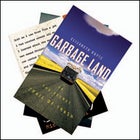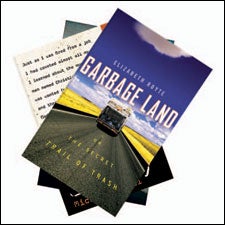Garbage Land
From Our Pages
Correspondent Peter Stark takes on uncharted whitewater and roiling 30-foot drops—along with Hummer-size hippos and riled-up crocodiles—inAt the Mercy of the River (Random House, ), a harrowing account of the first descent of Mozambique’s 400-mile Lugenda River. Stark first wrote about his adventure—a 15-day trip-scouting expedition through one of southern Africa’s wildest, most remote landscapes—in .

On the Secret Trail of Trash
By Elizabeth Royte
(Little, Brown, $25)
“PEOPLE THINK there’s a garbage fairy,” a New York City sanitation worker tells Elizabeth Royte. “You put your trash on the curb, and then pffft, it’s gone. They don’t have a clue.” A couple of years ago, Royte, author of 2001’s The Tapir’s Morning Bath, decided to follow her refuse and see where it led her. Given that the average American generates 1.31 tons of garbage a year, she writes, “I became increasingly curious to learn what sort of impact my own 1.31 tons had as it meandered through the landscape.” The result is Garbage Land, an eye-opening ride through the culture of waste disposal. Royte tails her local “san men” on their rounds in Brooklyn as they dodge “disco rice” (maggots) and stash “mongo” (trash worth saving) in the cab of their truck. Like amateur anthropologists, she writes, they “determined residents’ wealth or poverty by the artifacts they left behind.” Royte follows her trash to landfills, her metal recyclables to their shredding point in a Prolerizer (think of a garbage disposal for Buicks), and her toilet flushings to a “biosolid” fertilizer plant. Her conclusion? “We don’t need better ways to get rid of things. We need to not get rid of things, either by keeping them cycling through the system or not designing and desiring them in the first place.”—Bruce Barcott
True Story
Murder, Memoir, Mea Culpa
By Michael Finkel
(HarperCollins, $26)
TRUE STORY is a memoir as creepy as it is compelling. It starts in 2002, when the author, a 32-year-old magazine writer, gets “very publicly” fired from his gig at The New York Times Magazine after he fictionalizes a character in a story about child slavery in Africa. Humiliated and filled with self-loathing—but still a reporter with a nose for a good story—Finkel learns that a man named Christian Longo, after allegedly killing his wife and three children in Oregon, has been arrested in Mexico, where he was hiding under the assumed name of a New York Times journalist: Michael Finkel. It was “the journalistic equivalent of a winning lottery ticket,” Finkel writes. “The beginnings of my redemption, both professional and personal, might somehow lie with Longo.” And so begins a strange, intense relationship between the two men from their respective exiles in Bozeman, Montana, and a jail cell in Lincoln County, Oregon. Each desperate in his own way, the two alternately befriend and manipulate each other through hundreds of phone calls and letters. “Longo was the only person in my life I felt morally superior to, and something about this situation produced in me an unexpected openness,” Finkel writes of his odd fondness for the suspect. And through Longo, he gains tough insights into himself. “The flawed parts of my own character—the runaway egotism, the capacity to deceive—were mirrored and magnified in him,” he writes. What starts out as a tale of raw neediness ends as an apologia expertly and suspensefully told.—Florence Williams
A Field Guide to Getting Lost
By Rebecca Solnit
(Viking, $22)
REBECCA SOLNIT, one of the American West’s leading cultural thinkers and the author of Wanderlust: A History of Walking (), has a mind that roams over deserts, canyons, and forests. In her latest book, a collection of essays about her wanderings from New York to California, the San Francisco–based author explores the idea of getting lost, both literally and metaphorically. “Leave the door open for the unknown, the door into the dark,” she advises. “That’s where the most important things come from, where you yourself came from, and where you will go.” Solnit sees straying off path not as a condition that requires rescue but as a necessary part of life. Frontier explorers were never lost, she notes: “Being off course for a day or a week wasn’t a disaster for those who didn’t keep a tight schedule, knew how to live off the land, how to track, how to navigate by heavenly bodies…” Solnit’s lyrical, gently meandering essays draw on an eclectic array of sources, from Plato’s dialogues to Hitchcock’s Vertigo, all in service of answering what she calls the “basic tactical question in life”: How to lose your old self and find your new one.—B. B.

